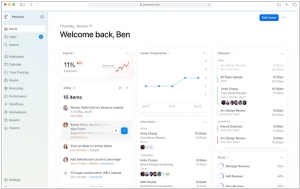Terraform vs VMware Aria
October 06, 2024 | Author: Michael Stromann
12★
Write infrastructure as code using declarative configuration files. HashiCorp Configuration Language (HCL) allows for concise descriptions of resources using blocks, arguments, and expressions.
5★
VMware Aria (formerly vRealize Cloud Management and CloudHealth by VMware Suite) is a unified management solution for cloud native applications and multi-cloud environments.
See also:
Top 10 Cloud Management platforms
Top 10 Cloud Management platforms
Terraform and VMware Aria are a bit like two rival spaceports offering passage to the vast, confusing and not entirely reliable realm of cloud infrastructure. Terraform, built by the ever-optimistic folks at HashiCorp, is like a multi-dimensional travel agent who can book you a ticket to just about anywhere in the galaxy—assuming, of course, you’ve mastered the intricate art of speaking in infrastructure as code (IaC). Whether you’re heading to AWS, Azure, or some far-flung corner of the multi-cloud universe, Terraform can whip up your digital vessel and keep track of all the interstellar complexities with a sort of casual swagger, all while letting you feel remarkably in control of your chaotic surroundings.
VMware Aria, on the other hand, is more like a high-tech butler in a shiny, specialized suit, quietly working behind the scenes in VMware’s cushy, cloud-native mansion. It doesn’t offer to take you everywhere in the known universe—just the best spots for VMware customers—but it excels at making sure everything is as seamless as afternoon tea with a side of IaaS. While Terraform goes gallivanting across the stars with its universal toolkit, VMware Aria focuses on polishing the brass and straightening the cushions for those who prefer their cloud infrastructure within the familiar, slightly posh confines of the VMware ecosystem.
In short, Terraform is your jack-of-all-clouds, ever ready for a daring leap into the unknown, while VMware Aria is more like the trusted valet of virtual machines, keeping things neat, tidy and ready for your next cloud-native adventure.
See also: Top 10 Cloud Management platforms
VMware Aria, on the other hand, is more like a high-tech butler in a shiny, specialized suit, quietly working behind the scenes in VMware’s cushy, cloud-native mansion. It doesn’t offer to take you everywhere in the known universe—just the best spots for VMware customers—but it excels at making sure everything is as seamless as afternoon tea with a side of IaaS. While Terraform goes gallivanting across the stars with its universal toolkit, VMware Aria focuses on polishing the brass and straightening the cushions for those who prefer their cloud infrastructure within the familiar, slightly posh confines of the VMware ecosystem.
In short, Terraform is your jack-of-all-clouds, ever ready for a daring leap into the unknown, while VMware Aria is more like the trusted valet of virtual machines, keeping things neat, tidy and ready for your next cloud-native adventure.
See also: Top 10 Cloud Management platforms





